This was published 8 years ago
Maramures, Romania: Welcome to the heart of Romania, the land time forgot
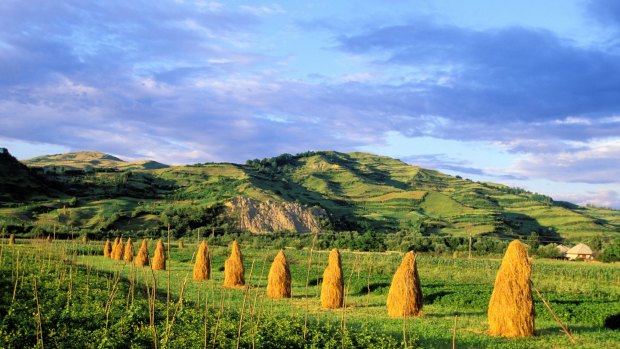
Romania, Maramures region, Carpathians mountains.Credit: Alamy
Our drive from Baia Mare (the capital of Maramures County, one of 41 counties in Romania) to historical Maramures only takes an hour or so, but we leave behind shops, banks, fast-food restaurants and everything I know about modern life and enter a semi-medieval world that I thought only existed in my pre-teen imagination.
Locals, most in traditional hand-woven garb, get about by foot and transport goods using horse-drawn carts. Cows are still milked by hand. Hay is handmade – it's cut with hacks, then turned using wooden pitchforks, hung over fences to dry and finally shaped into haystacks. Hundreds of these hand-formed haystacks are dotted over a vastness of undulating hills, fields carpeted with wildflowers, and emerald green pastures that seem to stretch on forever.
I gaze inquisitively at everything and question my affable guide, Rada Pavel, incessantly. It's not every day you see jovial women in patterned headscarves pushing wheelbarrows crammed with mushrooms and wild berries, or a runaway boar flying down the street with its owner in hot pursuit, or kids actually playing with each other – no iPhones in sight. Rada laughs at my bemusement. "You'll love it here – if you don't mind roughing it up and going with the flow."
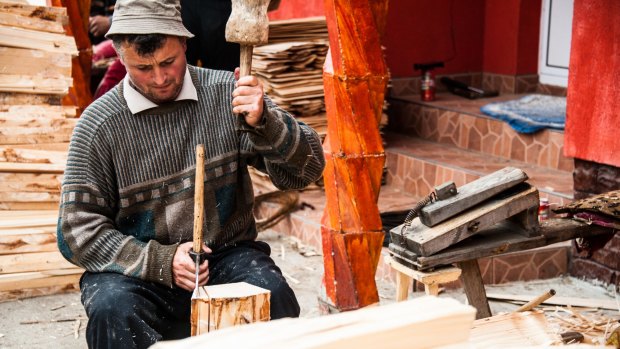
Woodcarving in "The Land of Wood".Credit: Photography Tours Romania
Maramures is not for luxury travellers, or tourists who need to stick to schedules, or folks who can't eat gluten or wheat or sugar. No, this rural fairytale is for adventure-seeking wanderers yearning to get lost in another world – to eat with the locals, to drink too much hornica (local plum brandy) and to do as the locals do.
Our accommodation is at the Village Hotel in Breb, one of 50 or so villages in the historic region. Managed by expat husband-and-wife team Duncan and Penelope Ridgley (who originally hail from the UK), the "hotel" is essentially a small collection of wooden lodges with original facades and refurbished interiors that are designed to depict customary village life, albeit with a few additional comforts such as modern kitchens and flushing toilets. Dinner is at a local's home nearby.
Restaurants as we've come to know them are thin on the ground in historical Maramures. Instead, most travellers prebook to dine at a guesthouse or enjoy a pre-arranged meal in a local's home for a fee. Tonight Duncan and Penelope are testing out a new family and the four of us navigate a labyrinth of muddy lanes until we get to a wooden house. The rosy-cheeked host welcomes us with a smile and shots of hornica. "It's rude to say no to hornica," Rada says. "You will find yourself tipsy often here."
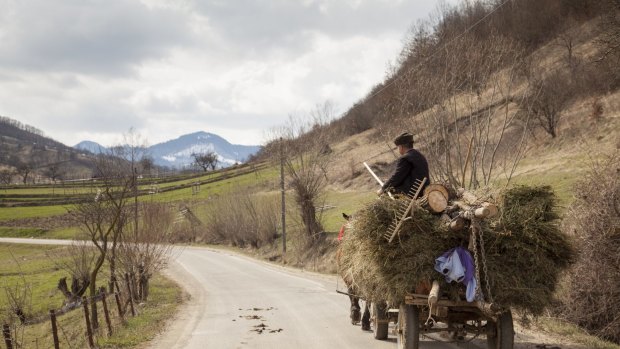
A farmer using the local time-honoured mode of transport.
Meals are the only component pre-arranged over the next few days (Rada explains we need to inform hosts if we want to eat at their premises so they can pick the vegetables and prepare the food). We wing it when it comes to the rest.
Maramures is known as the "land of wood" and visiting the wooden churches with their stunning frescoed interiors and admiring wooden abodes with their ornate traditional entrance gates is why many visitors come. The renowned gates are always much taller than the rest of the fencing, designed so full hay carts can easily get in.
Historically the people of Maramures relied on the abundance of wood from the surrounding Carpathian Mountains. They built churches, residences, chicken coops, piggeries, barns, toys and tools using the local timber. Today there are modern concrete homes too, but the importance of wood remains.
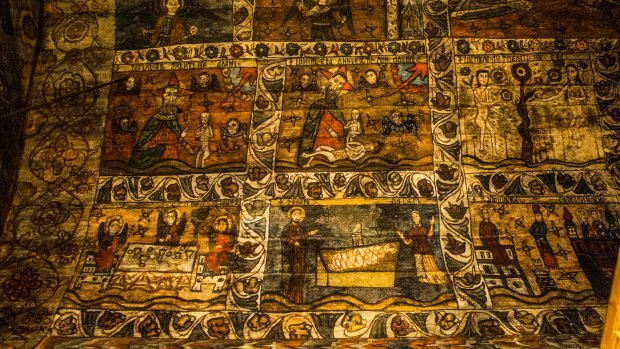
Mural paintings inside Saint Parascheva church.
UNESCO has acknowledged eight of the wooden churches in Maramures as World Heritage sites and our first stop is one of the most spectacular – the Saint Nicholas wooden church of Budesti-Josani in the village of Budesti. Rada explains that this particular church is a good example of a traditional Maramures church because it still retains its original shape. Although there has been a facelift or two (this is the case with most of the churches in the region), the interior of the church is still home to magnificent, elaborate frescoes by legendary icon painter Alexandru Ponehalschi. We spend an hour taking it in, as Rada explains the meaning of some icons, Duncan snaps away and I soak it all up.
We also visit the Birth of Holy Mary wooden church of Calinesti Josani in Caeni village and the Saint Parascheva wooden church in Desesti. Some churches in the region have been reconstructed using segments of the original church, others are alleged to be original. They all have two things in common though: brilliantly striking iconography (or remnants thereof) inside and construction from local timber.
Rada and Duncan insist on taking me to visit a carpenter so I can appreciate the deep relationship locals have with wood. It's decided that Patru Godja Pupaza (a distinguished local carver known also for his fondness for hornica) is the man for the job as he'll be the most interesting to chat to.
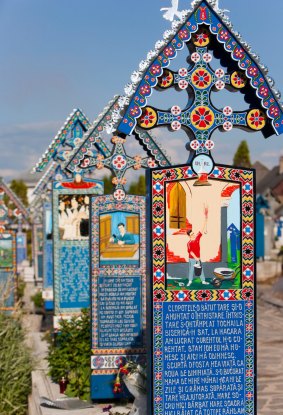
Merry Cemetery, Sapanta in Maramures.Credit: Alamy
We wind along a dirt road through rolling valleys and sleepy villages reminiscent of the ones in my childhood bedtime stories. I half expect to see Hansel and Gretel breaking into a wooden house around the corner. When we finally pull into the village of Valea Stejarului, we ask where we can find Pupaza. Not surprisingly we're pointed in the direction of a beautiful wooden dwelling, where the first thing I notice is the intricate detailing of the entrance gate.
Pupaza, now in his late 80s, has been a carpenter since his teenage years and still crafts traditional wooden gates for customers. With Rada translating, he explains that it can take weeks to build one gate and he usually works with his son-in-law. After showing us the gate, Pupaza hobbles around his yard pointing out various designs he is working on, visibly enjoying the attention. There's another complex carved gate, a striking dining room set, and plenty of wooden knick-knacks in different states of completion. We spend the afternoon playing with Pupaza's take on a Rubik's cube while downing hornica.
We are offered hornica again when we stop by the Haiduceanus' home-cum-"laundromat" in the village of Sarbi. We watch the clearly very in-love Vasile and Juje beat soapy carpets while humming folk songs, looking up every so often to smile affectionately at each other.
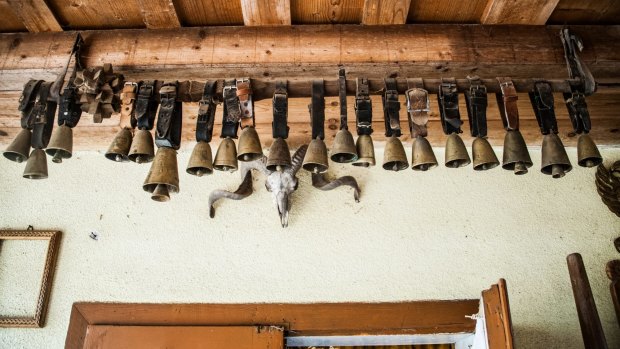
Decorative cowbells in Patru Godja Pupaza's workshop. Credit: Photography Tours Romania
Water is channelled from a fast-flowing stream into a massive wooden thresher, the wooden paddles moving quickly and powerfully to wash the carpets, coats and blankets. After the laundry is deemed clean it is dried.
I try to help where I can but quickly realise my thresher-washing dexterity is not up to scratch and revert to playing roll-the-truck-tyre-up-and-down-the-mud with their grandson Florian.
On the way back to the hotel, I'm not the least bit surprised when Rada and Duncan "need" to detour past a distillery. We plop ourselves down next to a group of local larrikins doing what they do best. In between shots and laughs, I realise I'm face to face with the Maramures of today, yesteryear and quite possibly tomorrow – joyous, content and not too concerned with life beyond the village periphery.
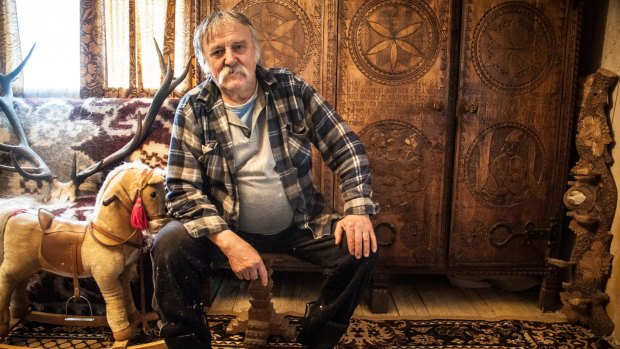
Patru Godja Pupaza and his handmade, hand-decorated wardrobe.Credit: Photography Tours Romania
FIVE MORE THINGS TO DO IN MARAMURES
1 RIDE THE MOCANITA STEAM TRAIN
The Mocanita Steam Train is the only remaining, functioning narrow-gauge forestry train used for timber transport in Europe. The picturesque journey ascends 50 kilometres through the Vaser Valley, passing the occasional tiny community and not much else.
2 WORK IN MARAMURES
Duncan Ridgley is also the founder of social networking site Working Traveller, which connects travelling workers to employment opportunities. It's a great way to gain experience in your chosen field while on the road – and Romania is as interesting as it gets. See www.workingtraveller.com.
3 VISIT THE MERRY CEMETERY
Chuckle about death – really. The Merry Cemetery is a collection of wooden-cross grave markers comically depicting the way a person passed away through the use satirical verses and illustrations. The imaginative designs represent the locals' beliefs that death is not the end but the beginning.
4 ENJOY THE OUTDOORS
One of the best ways to engage with the locals and environment is by walking and/or cycling through the region. There are plenty of routes suitable for varying degrees of ability levels.
5 THE SIGHET MUSEUM
On the other end of the scale, The Sighet Museum, housed in a former prison, is a sensitive and poignant museum that reveals some of the horrors that occurred in Romania during the communist era. See www.memorialsighet.ro.
TRIP NOTES
MORE INFORMATION
GETTING THERE
Fly to Bucharest via London with Qantas from Sydney or Melbourne. See www.qantas.com.au . From Bucharest travel to Maramureș by train. If coming from Hungary, Budapest to Baia Mare by road is comfortable by minivan. See www.janositrans.ro.
TOURING THERE
For customised tours book with Rada Pavel. Rada spent eight years working for the Maramures Tourist Information office is now a freelance guide. See www.prorada.wordpress.com. Duncan Ridgley is a former UK paparazzo and his photography tours are a wonderful way to soak up rural life. See www.photographytoursromania.com.
SLEEPING THERE
The enchanting Village Hotel in Breb is managed by the Ridgleys and manned by the twosome and a team of friendly village locals. Accommodation options range from double rooms situated in the main house to large private cabins that can sleep groups. See www.villagehotelmaramures.com.
The writer was a guest of Romania Tourism.
Sign up for the Traveller Deals newsletter
Get exclusive travel deals delivered straight to your inbox. Sign up now.